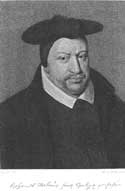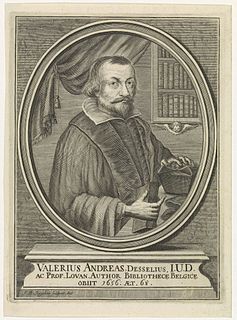

Cornelius Wytfliet or Cornelis van Wytfliet (died around 1597) was a geographer from Leuven in the Habsburg Netherlands, best known for producing the first atlas of the Americas. [1]


Cornelius Wytfliet or Cornelis van Wytfliet (died around 1597) was a geographer from Leuven in the Habsburg Netherlands, best known for producing the first atlas of the Americas. [1]
Cornelius was the son of Catherine Huybrechts and her husband, Gregorius Wytfliet, who was advocate fiscal of Leuven University from 1557 to 1594. [2]
After graduating Licentiate in Laws from the University of Leuven, Wytfliet moved to Brussels and became secretary to the Council of Brabant. He died in or shortly after 1597, when his Descriptionis Ptolemaicae Augmentum (a work adding new discoveries to Ptolemy's description of the world) was published. [2]
Adriaan van Roomen, also known as Adrianus Romanus, was a mathematician, professor of medicine and medical astronomer from the Duchy of Brabant in the Habsburg Netherlands who was active throughout Central Europe in the late 16th and early 17th centuries. As a mathematician he worked in algebra, trigonometry and geometry; and on the decimal expansion of π. He solved the Problem of Apollonius using a new method that involved intersecting hyperbolas. He also wrote on the Gregorian calendar reform.

The Diocese of Antwerp is a diocese of the Catholic Church in Belgium. The diocese was restored in 1961. It is a suffragan of the Archdiocese of Mechelen-Brussels. Its see is the Cathedral of Our Lady.

Joannes Molanus (1533–1585), often cited simply as Molanus, is the Latinized name of Jan Vermeulen or Van der Meulen, an influential Counter Reformation Catholic theologian of Louvain University, where he was Professor of Theology, and Rector from 1578. Born at Lille, he was a priest and canon of St. Peter's Church, Leuven, where he died.

The Council of Brabant was the highest law court in the historic Duchy of Brabant. It was presided over by the Chancellor of Brabant. One of its functions was to determine that new legislation was not contrary to the rights and liberties established in the Joyous Entry.
Rutger Velpius was a 16th- and 17th-century printer and bookseller. He was the first printer in the city of Mons, and later became printer to the court in Brussels. His career coincided closely with the first decades of the Dutch Revolt
Lodewijk Makeblijde (1565–1630) was a Flemish Jesuit and a Renaissance poet and hymn writer.
Jacobus Zegers was an academic printer and bookseller in Leuven, with many clients among the faculty of Leuven University. He was the printer of Cornelius Jansen's Augustinus (1640).

Ambrosius Capello (1597–1676) was the seventh bishop of Antwerp (1654–1676).
Nicolas de Montmorency, count of Estaires, was an office holder and spiritual author in the Spanish Netherlands.
Gerard van Rivieren, Latinized Gerardus Rivius was a printer in the Southern Netherlands. He was the publisher of Martin Delrio's famous witchcraft treatise Disquistiones Magicae and was at one time suspected of having printed Corona Regia, a satire on James I of England that caused diplomatic ructions. His printer's mark was a winged horse, and his motto "Totum sic irrigat orbem".
Cornelius Columbanus Vrancx (c.1530–1615) was the 60th abbot of St Peter's Abbey in Ghent.
Events in the year 1635 in the Spanish Netherlands and Prince-bishopric of Liège.
Events in the year 1600 in the Spanish Netherlands and Prince-bishopric of Liège.
Events in the year 1835 in Belgium.
Thomas Sailly (1553–1623) was a Jesuit military chaplain and author of devotional writings in the Spanish Netherlands.
Jean Moeller or Johannes Möller (1806–1862) was the first Professor of History at the Catholic University of Leuven.

Events in the year 1859 in Belgium.
Balthazar Ayala (1548–1584) was a military judge in the Habsburg Netherlands during the opening decades of the Eighty Years' War who wrote an influential treatise on the law of war.

Wouter Dries or Walter Driessens (1588–1655), Latinized Valerius Andreas, was an academic jurist, Hebraist, and historian from the Duchy of Brabant in the Habsburg Netherlands.
Martinus Nutius or Martin Nuyts was the name of three successive printer-booksellers in 16th and 17th-century Antwerp, active for almost a hundred years from 1540 to 1638.